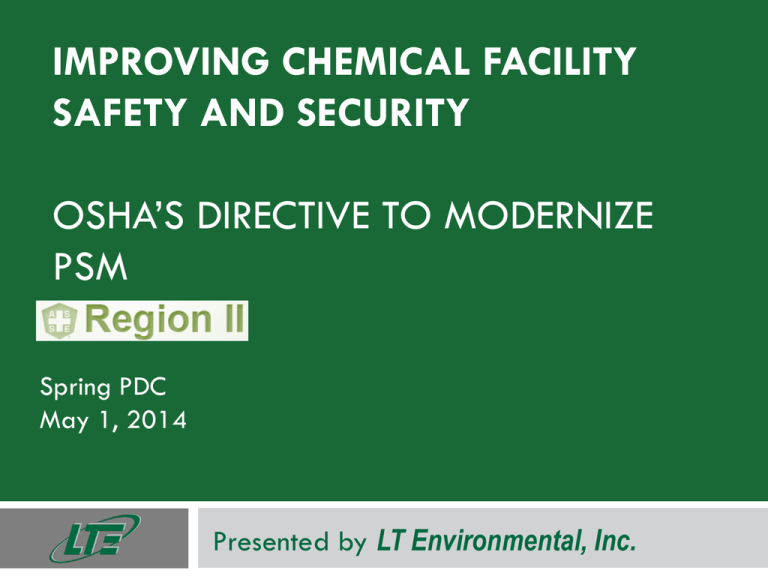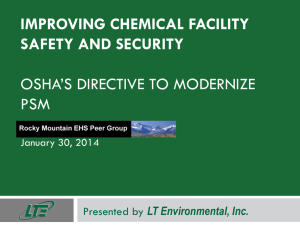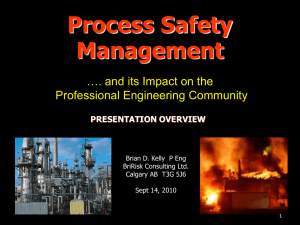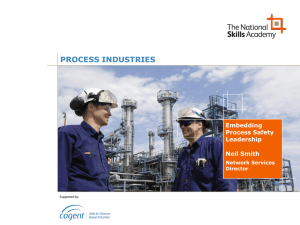Spring PDC PSM
advertisement

IMPROVING CHEMICAL FACILITY SAFETY AND SECURITY OSHA’S DIRECTIVE TO MODERNIZE PSM Spring PDC May 1, 2014 Presented by LT Environmental, Inc. Process Safety Management Process Safety Management of Highly Hazardous Chemicals (29 CFR 1910.119) Adopted May 26, 1992 Process Safety Management (PSM) is the application of management principles and systems to the identification, understanding, and control of process hazards to protect employees, facility assets, and the environment. Process Safety Management Employee Participation Process Safety Information Process Hazard Analysis Operating Procedures Employee Training Contractors Pre-Startup Safety Review Mechanical Integrity Hot Work (Non-routine Work Authorizations) Management of Change Incident Investigation Emergency Planning and Response Compliance Audits Application of Rule Appendix A of 29 CFR 1910.119 contains a listing of toxic and reactive highly hazardous chemicals which present a potential for a catastrophic event at or above the threshold quantities listed. Application of Rule The PSM regulation applies to facilities that have processes meeting one or both of the following criteria. The facility contains or stores: A quantity in excess of 10,000-lb of a flammable liquid or gas. Highly hazardous toxic or reactive chemicals that exceed the established threshold quantities as listed in the regulation. Anhydrous ammonia Chlorine Hydrogen sulfide Threshold quantity = 10,000-lb Threshold quantity = 1,500-lb threshold quantity = 1,500-lb Application of Rule Currently Exempts Retail facilities Application of Rule Currently Exempts Oil and gas well drilling or servicing Application of Rule Currently Exempts Hydrocarbon fuels used solely for workplace consumption as a fuel, if such fuels are not part of a process containing another highly hazardous chemical covered by this standard Application of Rule Currently Exempts Flammable liquid stored in atmospheric tanks or transferred, which are kept below their normal boiling point without benefit of chilling or refrigerating and are not connected to a process Application of Rule Currently Exempts Normally unoccupied remote facilities “Normally unoccupied remote facility” means a facility which is operated, maintained, or serviced by employees who visit the facility only periodically to check its operation and to perform necessary operating or maintenance tasks. No employees are permanently stationed at the facility. Facilities meeting this definition are not contiguous with, and must be geographically remote from all other buildings, processes, or persons. OSHA Interpretation letter = average 14 hours per week Executive Order 13650 On August 1, 2013, President Obama signed Executive Order 13650, entitled “Improving Chemical Facility Safety and Security” Went to: DOJ DOT EPA OSHA HSA Executive Order 13650 9/1/2013 - OSHA Authorizes enhanced information collection with the purpose of suggesting changes to the PSM Standard Asked 17 Questions on Topics of Potential Rulemaking or Policy Change Potential Rulemaking or Policy Change Clarifying the PSM exemption for atmospheric storage tanks Original intent to include but excluded by a judge’s ruling in 1997. OSHA wants to include atmospheric storage tanks within or connected to a process. Not terminals or tank batteries, but…. Potential Rulemaking or Policy Change Removing the oil & gas well drilling and servicing exemption Original pre-amble stated that these would be exempt from this rule because a separate one would be established. What would be covered under the thresholds? Potential Rulemaking or Policy Change Removing the oil & gas production facility exemption Originally included, however an objection by API about OSHA not completing an economic analysis on this portion stayed enforcement. What about multiple well site pads? Potential Rulemaking or Policy Change Expanding PSM Coverage and Requirements for Reactivity Hazards A number of the listed chemicals are highly reactive but the list does not cover all highly reactive chemicals. Recommended approach takes into account not only certain specific chemicals but also their overall reactivity in determining the level of coverage. Potential Rulemaking or Policy Change Updating the List of Highly Hazardous Chemicals The list has remained unchanged since OSHA promulgated the PSM standard in 1992. Current list provides specific concentrations for 11 of 137 listed chemicals. OSHA has issued interpretation considering PSM coverage to apply if threshold quantities of such chemicals are present at commercial grade which OSHA has interpreted as "a typical maximum concentration of the chemical that is commercially available and shipped." In a court case resulting from an explosion involving hydroxylamine, a U.S. District Court dismissed a criminal indictment based on inconsistencies in OSHA's statements regarding coverage of hydroxylamine. Potential Rulemaking or Policy Change Revising the PSM Standard to Require Additional Management-System Elements Adopt management system elements from safety standards that other federal agencies or professional societies have promulgated since 1992 Center for Chemical Process Safety (CCPS) has defined a Risk-Based Process Safety (RBPS) Bureau of Safety and Environmental Enforcement's Safety and Environmental Management System (SEMS) Potential Rulemaking or Policy Change Require Evaluation of Updates to Applicable recognized and generally accepted good engineering practices (RAGAGEP) Definition - Center for Chemical Process Safety: RAGAGEP are the basis for engineering, operation, or maintenance activities and are themselves based on established codes, standards, published technical reports or recommended practices (RP) or similar documents. Potential Rulemaking or Policy Change Expanding PSM Standard to Cover the Mechanical Integrity of Any Safety-Critical Equipment Currently applies to pressure vessels, storage tanks, piping systems (including piping components such as valves), relief and vent devices, emergency shutdown systems, controls (including monitoring devices, sensors, alarms, and interlocks), and pumps. if an employer deems additional equipment to be critical to a particular process, the employer should consider that equipment to be covered by MI requirements. Potential Rulemaking or Policy Change Clarifying PSM Standard with explicit requirement to manage organizational changes The Management of Change (MOC) element in the PSM Standard did not include or contemplate organizational changes. OSHA’s current interpretation of the PSM Standard MOC provisions is that if changes to personnel, budgets, etc., can affect process safety then they should be covered by MOC. Potential Rulemaking or Policy Change Require Coordination of Emergency Planning with Local Emergency-Response Authorities beyond LEPCs The PSM standard requires employers to establish and implement an emergency action plan in accordance with other OSHA standards. However, the standard does not require employers to coordinate emergency planning with local emergency response authorities. Potential Rulemaking or Policy Change Requiring third-party compliance audits Current Standard requires a facility audit every three years, but no requirements for make up of audit team. Safety and Environmental Management System (SEMS) standard from Bureau of Safety and Environmental Enforcement (BSEE) requires the audit lead be an independent third party, may be expanded to certified third party. Potential Rulemaking or Policy Change Cover Dismantling and Disposal of Explosives, Blasting Agents, and Pyrotechnics The standard applies to the manufacture, keeping, having, storage, sale, and transportation of explosives, blasting agents, and pyrotechnics but it does not apply to the sale and use of fireworks or the use of explosives. Dismantling and disposing of explosives are not covered by the standard. Potential Rulemaking or Policy Change Address the Storage, Handling, and Management of Ammonium Nitrate Not currently covered. OSHA is seeking comments on safe work practices for storing, handling, and managing ammonium nitrate. Potential Rulemaking or Policy Change Changing Enforcement Policy of the PSM Exemption for Retail Facilities The term retail facility is not defined in the standard. The preamble to the standard noted that chemicals in retail facilities are generally in small packages, containers, and allotments, and gives the example of gasoline stations as a type of facility that typically would qualify for the exemption. Potential Rulemaking or Policy Change Changing Enforcement Policy for Highly Hazardous Chemicals Contact: LT Environmental, Inc. 4600 West 60th Avenue Arvada, Colorado 80003 303-433-9788 Jeff Citrone, CIH, CSP, REA jcitrone@ltenv.com 303-962-5494 Compliance, Remediation, Engineering





